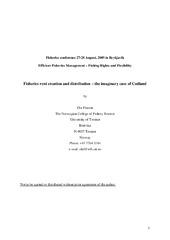| dc.description.abstract | This paper discusses actual and possible achievements and failures of Codland and examines it from the point of view of efficiency and in terms of distribution. It is argued in favour of the joint analysis of the two approaches when contemplating fisheries management reforms, since such reforms may create both winners and losers. The analysis demonstrates how rent drain from fishing communities and countries may occur despite significant resource rent creation. The change of the Codland economy is illustrated and compared to that of actual countries and to resource economic theory. It is concluded that if distributional and equity objectives matter, other instruments than ITQs, such as conditional tradable fish quotas and vessel licenses, resource taxes, co-management, public ownership, auctions, leases, time limited rights, time and area regulations, territorial user rights (TURFs) and marine protected areas (MPAs), should also be used. | en |


 English
English norsk
norsk